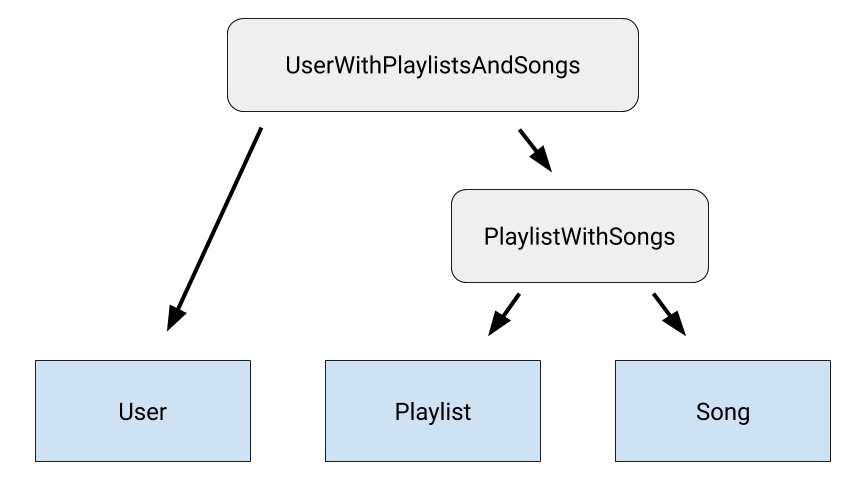Czasami może być konieczne wysłanie zapytania do zbioru co najmniej 3 tablic, które są ze sobą powiązane. W takim przypadku definiujesz zagnieżdżone relacje między tabelami.
Załóżmy, że w przykładzie aplikacji do odtwarzania strumieniowego muzyki chcesz wysłać zapytanie dotyczące wszystkich użytkowników, wszystkich playlist dla każdego użytkownika oraz wszystkich utworów na każdej playliście dla każdego użytkownika. Użytkownicy mają relację jeden-do-wielu z playlistami, a playlisty mają relację wiele-do-wielu z utworami. Poniższy przykład kodu zawiera klasy reprezentujące te elementy oraz tabelę odniesień dla relacji „wiele do wielu” między playlistami a utworami:
Kotlin
@Entity
data class User(
@PrimaryKey val userId: Long,
val name: String,
val age: Int
)
@Entity
data class Playlist(
@PrimaryKey val playlistId: Long,
val userCreatorId: Long,
val playlistName: String
)
@Entity
data class Song(
@PrimaryKey val songId: Long,
val songName: String,
val artist: String
)
@Entity(primaryKeys = ["playlistId", "songId"])
data class PlaylistSongCrossRef(
val playlistId: Long,
val songId: Long
)
Java
@Entity
public class User {
@PrimaryKey public long userId;
public String name;
public int age;
}
@Entity
public class Playlist {
@PrimaryKey public long playlistId;
public long userCreatorId;
public String playlistName;
}
@Entity
public class Song {
@PrimaryKey public long songId;
public String songName;
public String artist;
}
@Entity(primaryKeys = {"playlistId", "songId"})
public class PlaylistSongCrossRef {
public long playlistId;
public long songId;
}
Najpierw modeluj relację między 2 tabelami w zbiorze, jak to zwykle robisz, używając klasy danych i annotacji @Relation. Poniższy przykład przedstawia klasę PlaylistWithSongs, która modeluje relację „wiele do wielu” między klasą jednostek Playlist a klasą jednostek Song:
Kotlin
data class PlaylistWithSongs(
@Embedded val playlist: Playlist,
@Relation(
parentColumn = "playlistId",
entityColumn = "songId",
associateBy = Junction(PlaylistSongCrossRef::class)
)
val songs: List<Song>
)
Java
public class PlaylistWithSongs {
@Embedded public Playlist playlist;
@Relation(
parentColumn = "playlistId",
entityColumn = "songId",
associateBy = Junction(PlaylistSongCrossRef.class)
)
public List<Song> songs;
}
Po zdefiniowaniu klasy danych reprezentującej tę relację utwórz kolejną klasę danych, która modeluje relację między inną tabelą z Twojego zbioru a pierwszą klasą relacji, „zagnieżdżając” istniejącą relację w nowej. Ten przykład przedstawia klasę UserWithPlaylistsAndSongs, która modeluje relację jeden-do-wielu między klasą encji User a klasą relacji PlaylistWithSongs:
Kotlin
data class UserWithPlaylistsAndSongs(
@Embedded val user: User
@Relation(
entity = Playlist::class,
parentColumn = "userId",
entityColumn = "userCreatorId"
)
val playlists: List<PlaylistWithSongs>
)
Java
public class UserWithPlaylistsAndSongs {
@Embedded public User user;
@Relation(
entity = Playlist.class,
parentColumn = "userId",
entityColumn = "userCreatorId"
)
public List<PlaylistWithSongs> playlists;
}
Klasa UserWithPlaylistsAndSongs pośrednio modeluje relacje między wszystkimi 3 klasami jednostek: User, Playlist i Song. Widać to na rysunku 1.

Jeśli w Twoim zbiorze jest więcej tabel, utwórz klasę, która będzie modelować relację między każdą z pozostałych tabel a klasą relacji modelującą relacje między wszystkimi poprzednimi tabelami. Spowoduje to utworzenie łańcucha zagnieżdżonych relacji między wszystkimi tabelami, do których chcesz kierować zapytania.
Na koniec dodaj do klasy DAO metodę, która udostępnia funkcję zapytania potrzebną aplikacji. Ta metoda wymaga, aby Room wykonywał wiele zapytań, więc dodaj adnotację @Transaction, aby cała operacja była wykonywana autonomicznie:
Kotlin
@Transaction
@Query("SELECT * FROM User")
fun getUsersWithPlaylistsAndSongs(): List<UserWithPlaylistsAndSongs>
Java
@Transaction
@Query("SELECT * FROM User")
public List<UserWithPlaylistsAndSongs> getUsersWithPlaylistsAndSongs();

